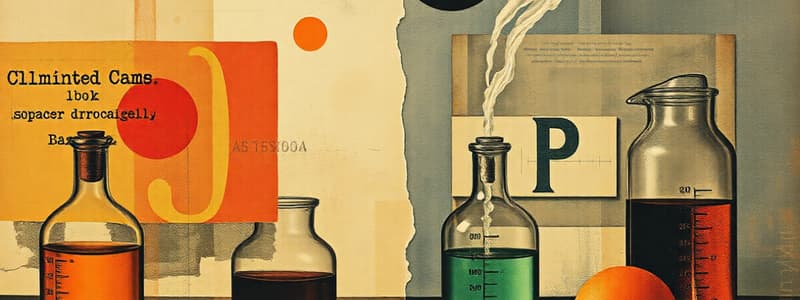Podcast
Questions and Answers
What should you do after bringing the water in the beaker to a boil?
What should you do after bringing the water in the beaker to a boil?
Make and record careful observations.
What should be used to hold the sponge over the beaker while the water boils?
What should be used to hold the sponge over the beaker while the water boils?
Tongs
What is the purpose of squeezing the sponge after letting it cool?
What is the purpose of squeezing the sponge after letting it cool?
To record the observations.
What substance is added to the well-plate along with magnesium ribbon?
What substance is added to the well-plate along with magnesium ribbon?
What does the apparatus in Figure 1 primarily used for?
What does the apparatus in Figure 1 primarily used for?
What apparatus is used to boil water in the provided instructions?
What apparatus is used to boil water in the provided instructions?
What is the first step in the process of boiling water with a Bunsen burner?
What is the first step in the process of boiling water with a Bunsen burner?
What should you use to hold the sponge over the beaker?
What should you use to hold the sponge over the beaker?
What concentration of hydrochloric acid (HCl) is mentioned for use in the experiment?
What concentration of hydrochloric acid (HCl) is mentioned for use in the experiment?
What material is to be added to the hydrochloric acid in the well-plate?
What material is to be added to the hydrochloric acid in the well-plate?
Study Notes
Apparatus for Boiling Water
- Ring stand, stirring rod, 250-ml beaker, wire gauze, and Bunsen burner are essential equipment for boiling water.
- The Bunsen burner should be adjusted so that the hottest part of the flame directly touches the bottom of the beaker.
Procedure for Boiling Water
- Light the Bunsen burner and stabilize it under the beaker.
- Bring the water to a boil and make careful observations of the boiling process.
- Utilize tongs to hold a sponge above the boiling water for a few minutes, which allows for temperature changes and potential physical changes.
Observations and Cooling
- Place the sponge on the lab bench to cool after being heated by the steam of the boiling water.
- Squeeze the sponge after cooling and record any observations regarding its physical state changes.
Chemical Change Experiment
- A small piece of magnesium ribbon is introduced into a well-plate containing a few drops of 3.0 M HCl (hydrochloric acid).
- Make careful observations during the reaction to record any chemical changes, such as effervescence or color change.
Apparatus for Boiling Water
- Ring stand, stirring rod, 250-ml beaker, wire gauze, and Bunsen burner are essential equipment for boiling water.
- The Bunsen burner should be adjusted so that the hottest part of the flame directly touches the bottom of the beaker.
Procedure for Boiling Water
- Light the Bunsen burner and stabilize it under the beaker.
- Bring the water to a boil and make careful observations of the boiling process.
- Utilize tongs to hold a sponge above the boiling water for a few minutes, which allows for temperature changes and potential physical changes.
Observations and Cooling
- Place the sponge on the lab bench to cool after being heated by the steam of the boiling water.
- Squeeze the sponge after cooling and record any observations regarding its physical state changes.
Chemical Change Experiment
- A small piece of magnesium ribbon is introduced into a well-plate containing a few drops of 3.0 M HCl (hydrochloric acid).
- Make careful observations during the reaction to record any chemical changes, such as effervescence or color change.
Studying That Suits You
Use AI to generate personalized quizzes and flashcards to suit your learning preferences.
Related Documents
Description
Test your knowledge on physical and chemical changes through various examples and scenarios. This quiz covers key concepts regarding the characteristics and differences between physical reactions and chemical reactions. Prepare to enhance your understanding of these fundamental processes.




